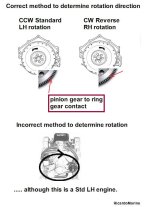Based on the information you have given, you have a reverse rotation ford 260 with a Eaton stern drive (most likely a Series 14 or 16).
Back during the early years, Eaton marketed Volvo Penta's stern drives tagged as "Eaton".
If his drive is one of these........, it will be a cone clutch drive.
The Volvo Penta cone clutch drive will ONLY work with a Standard LH rotation engine due to the direction of the vertical shaft's spiral splines and the "like" internal spiral splines within the sliding sleeve.
IOW, a Reverse RH rotation engine (CW from the flywheel end) will not allow the sliding sleeve to engage in the rotating gear cup.
If this is correct, the engine would make an decent Rat Rod engine. A couple of things to note:
1. Ford 260 is a member of the Windsor family of engines (221, 260, 289, 302, 351, 5.0).
The Windsor is in the 335 series Ford family if memory serves me..... yes/no?
3. Reverse rotation was accomplished in these engines by using a reverse rotation camshaft and distributor gear. everything else was the same as a regular rotation.
Wrist pin offset would also need to be reversed.
I would be interested in knowing what stern drive you have, is there any labels on the engine or stern drive?
This is why I made mention of the Eaton tagged Volvo Penta stern drive.
If he does have one of these, it will be a cone clutch stern drive.


